Alaska, the “Last Frontier,” is a land of breathtaking natural beauty, vast wilderness, and unique opportunities. Beyond its stunning landscapes and abundant resources, Alaska offers a quality of life rooted in strong communities and unparalleled access to outdoor adventure. With a dynamic job market and a unique cultural tapestry, finding the perfect spot in this immense state depends on what you value most. Whether you’re seeking urban amenities, a tight-knit rural community, or a base for exploring the wild, the best places to live in Alaska cater to diverse preferences.
Choosing a place to settle involves considering factors like community well-being, cost of living, job prospects, and access to education and healthcare. Alaska presents specific challenges and rewards, from long daylight hours in summer to extended winter nights, and the unique character of each town reflects its history and environment. We’ve explored various locations across the state to highlight those that stand out for their livability and appeal, helping you discover where your Alaskan dream could take shape.
Top 10 Best Places To Live In Alaska in 2025
Here is our ranking of the top cities offering appealing living options in the Last Frontier State. We’ve evaluated each location based on key factors such as housing trends, affordability, and overall quality of life. These places represent some of the strongest contenders for the best places to live in Alaska.
| City | Median House Price | Median Income | Cost of Living vs. US Avg. | Liveability Score | Crime Score (Higher is Safer) | Ranking Change |
|---|---|---|---|---|---|---|
| 1. Badger | $309K | $109K | 20.5% Higher | 57 | 15 | 5⬆️ |
| 2. Anchorage | $393K | $115K | 21.7% Higher | 77 | 5 | 1⬇️ |
| 3. Kodiak | $445K | $96K | 20.2% Higher | 65 | 32 | 7⬆️ |
| 4. Sitka | $510K | $108K | 21.4% Higher | 85 | 42 | 1⬆️ |
| 5. Ketchikan | $385K | $95K | 21.4% Higher | 76 | 8 | 3⬆️ |
| 6. Homer | $395K | $97K | 20.2% Higher | 70 | 34 | 1⬆️ |
| 7. Palmer | $385K | $83K | 20.2% Higher | 73 | 29 | 2⬆️ |
| 8. Fairbanks | $289K | $81K | 20.5% Higher | 56 | 3 | 6⬇️ |
| 9. Wasilla | $386K | $96K | 20.2% Higher | 60 | 4 | 5⬇️ |
| 10. Juneau | $490K | $114K | 22.9% Higher | 82 | 7 | 7⬇️ |
Exploring the 10 Best Places To Live In Alaska
Let’s take a closer look at the specific characteristics and appeal of each of these top locations in Alaska, highlighting what makes them great places to call home, from urban centers to smaller towns nestled in stunning environments.
1. Badger: A Hub for Education and Outdoors
- Median House Price: $309K
- Cost of Living: 20.5% Higher than the national average.
- Crime Score: Safer than 15% of U.S. cities.
- Unemployment: 6.6%
- Walkability Score: 3; Car-dependent.
Badger, a suburb located near Fairbanks, offers a convenient location with proximity to key educational institutions like the University of Alaska. This makes it an attractive option, particularly for students or those working in academia. The focus on education is a significant draw for many residents.
Beyond its educational links, Badger boasts a notably robust healthcare system, with a high percentage of the population having health coverage. The natural beauty surrounding the area provides ample opportunities for outdoor enthusiasts to engage in activities like hiking, fishing, and snowmobiling throughout the year.
2. Anchorage: The Urban Gateway
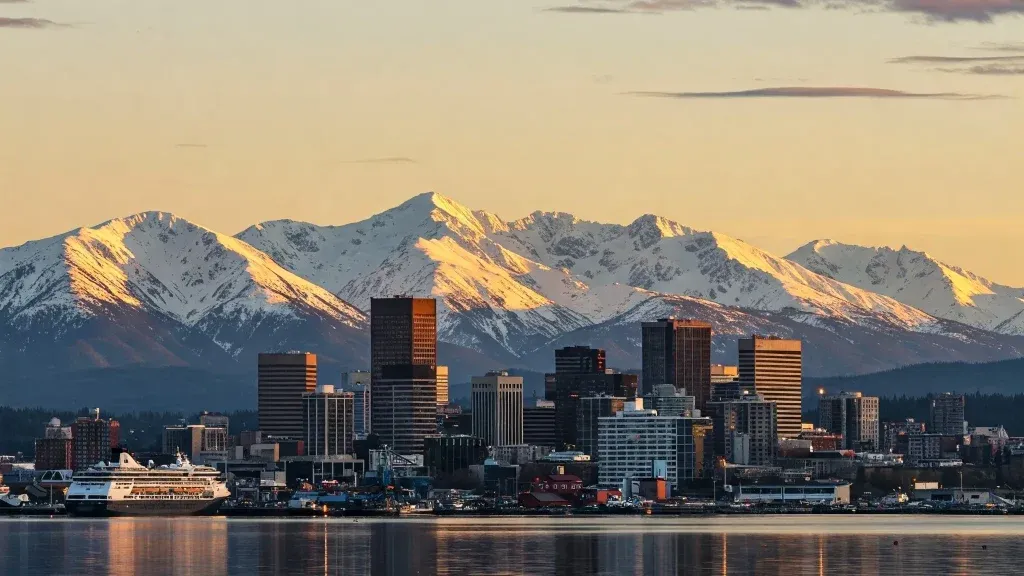 Anchorage city skyline with mountains in the background, a best place to live in Alaska
Anchorage city skyline with mountains in the background, a best place to live in Alaska
- Median House Price: $393K
- Cost of Living: 21.7% Higher than the national average.
- Crime Score: Safer than 5% of U.S. cities.
- Unemployment: 5.2%
- Walkability Score: 31; Car-dependent.
Anchorage stands as Alaska’s largest city and serves as its primary hub, often referred to as the “Gateway to Alaska.” Situated near the impressive Chugach State Park and the Cook Inlet, it offers a blend of urban conveniences and easy access to wild landscapes.
The city features a diverse and growing economy, with major employers contributing to job opportunities. Anchorage is also home to the University of Alaska Anchorage (UAA), adding to its appeal for those seeking higher education or working in related fields. While utility costs are higher than the state average, the city’s amenities and job market remain strong draws.
3. Kodiak: Island Life and Industry
- Median House Price: $445K
- Cost of Living: 20.2% Higher than the national average.
- Crime Score: Safer than 32% of U.S. cities.
- Unemployment: 4.8%
- Walkability Score: 0; Car-dependent.
Located on scenic Kodiak Island, Kodiak is widely recognized for its thriving crab fishing industry. While the cost of living sits above the national average, the city compensates with a high quality of life, fueled by its beautiful location and a stable local economy tied to the sea.
Kodiak fosters a strong sense of community, offering residents abundant opportunities for outdoor activities like fishing, hiking, and observing local wildlife, including the famous Kodiak bears. The city also provides solid educational facilities and healthcare services, making it a well-rounded option for families seeking a unique island lifestyle.
4. Sitka: Historic Beauty and Safety
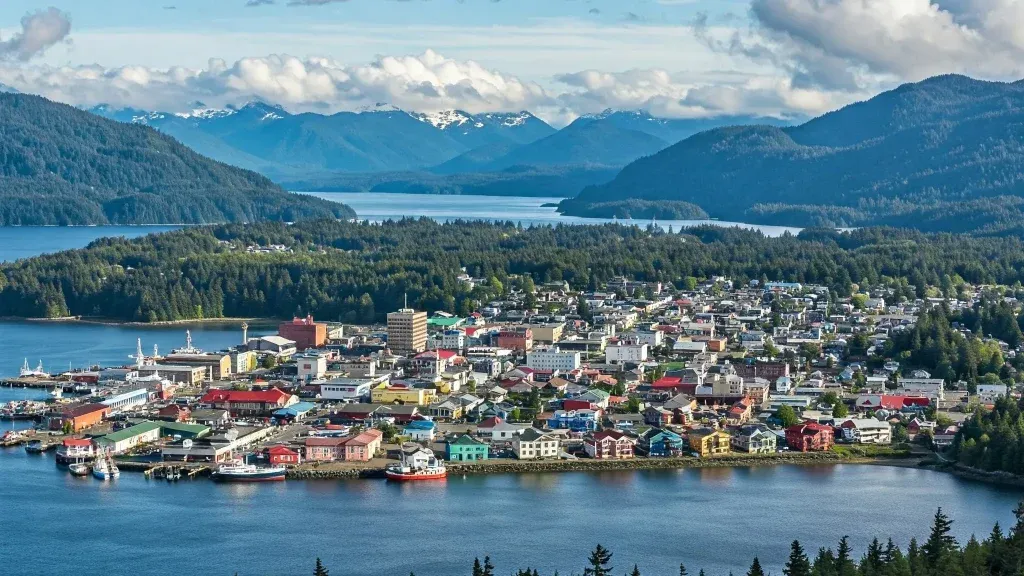 Coastal town of Sitka, Alaska with boats in the harbor
Coastal town of Sitka, Alaska with boats in the harbor
- Median House Price: $510K
- Cost of Living: 21.4% Higher than the national average.
- Crime Score: Safer than 42% of U.S. cities.
- Unemployment: 5%
- Walkability Score: 71; Very walkable.
Sitka, a charming coastal city on Baranof Island within the Tongass National Forest, is celebrated for its historical significance and stunning natural setting. It’s home to notable educational institutions, including a campus of the University of Alaska Southeast and Sheldon Jackson College, attracting students and academics.
Notably, Sitka stands out for its high safety rating, being safer than a significant portion of other U.S. cities. The median income here is also considerably higher than the national average, contributing to a desirable quality of life despite the higher cost of living. Its walkability adds to its urban appeal, making it easy to explore the town on foot.
5. Ketchikan: The Salmon Capital’s Appeal
- Median House Price: $385K
- Cost of Living: 21.4% Higher than the national average.
- Crime Score: Safer than 8% of U.S. cities.
- Unemployment: 5.1%
- Walkability Score: 72; Very walkable.
Ketchikan holds the global title of the ‘Salmon Capital of the World,’ reflecting the importance of the fishing industry to its economy and identity. Like many Alaskan cities, it has a cost of living above the national average, but its economy is robust, largely driven by fishing and a significant tourism sector.
Surrounded by the vast Tongass National Forest, Ketchikan provides residents and visitors alike with easy access to a wealth of outdoor activities amidst breathtaking scenery. The city also boasts a rich cultural heritage, evident in popular attractions such as the Totem Heritage Center and the Southeast Alaska Discovery Center, offering insights into local art and history.
6. Homer: Arts, Ocean, and Retirement
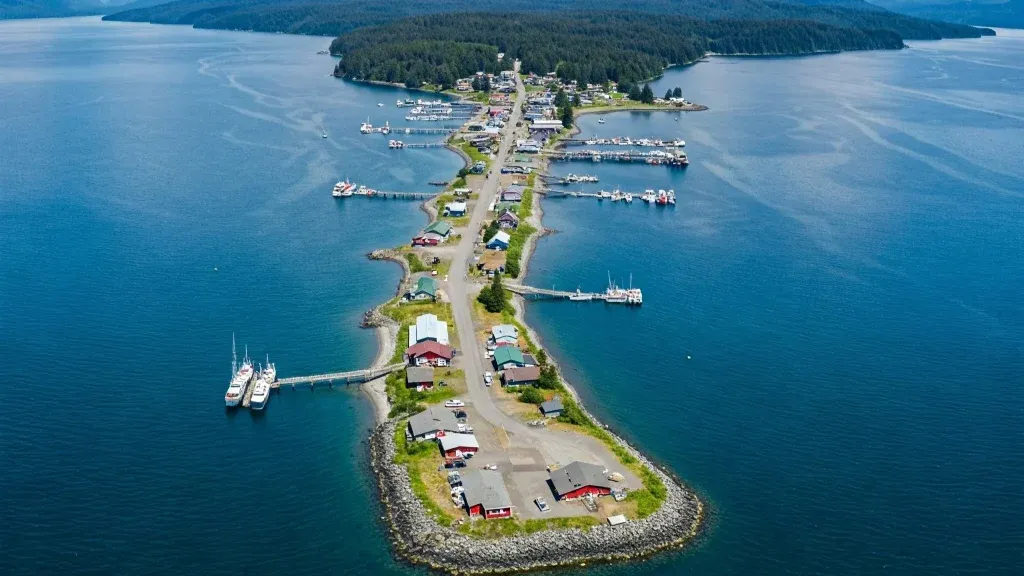 Scenic view of Homer Spit and bay in Homer, Alaska
Scenic view of Homer Spit and bay in Homer, Alaska
- Median House Price: $395K
- Cost of Living: 20.2% Higher than the national average.
- Crime Score: Safer than 34% of U.S. cities.
- Unemployment: 9%
- Walkability Score: 1; Car-dependent.
Located gracefully on the southern tip of the Kenai Peninsula, Homer offers a unique blend of artistic community and stunning marine environments. It’s known for being relatively more affordable than some other key Alaskan locations, making it particularly appealing to certain demographics.
Homer’s serene beauty, coupled with relatively affordable housing options and a decent safety score, positions it as an excellent choice for those considering retirement. Popular attractions like the Pratt Museum, the famous Homer Spit Trail, and the Alaska Islands & Ocean Visitor Center add to its cultural and recreational value.
7. Palmer: Agricultural Charm
- Median House Price: $385K
- Cost of Living: 20.2% Higher than the national average.
- Crime Score: Safer than 29% of U.S. cities.
- Unemployment: 9.6%
- Walkability Score: 42; Car-dependent.
Nestled in the fertile Matanuska Valley, Palmer is characterized by its strong agricultural roots and stunning scenic backdrop. It offers a more laid-back lifestyle compared to larger urban centers, appealing to those who appreciate rural living while still needing access to amenities.
Palmer is famously home to the annual Alaska State Fair, a major event that draws visitors from across the state and beyond. The city cultivates a tight-knit community atmosphere, hosting various local events throughout the year. It’s an ideal spot for individuals or families seeking a balance between country living and community engagement.
8. Fairbanks: Interior Hub and Economy
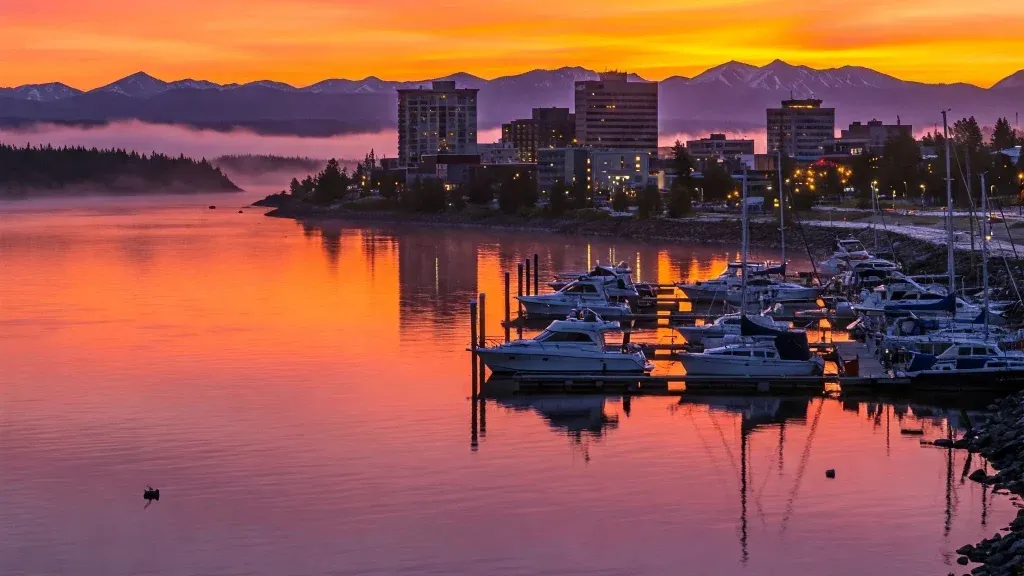 Downtown area of Fairbanks, one of the best places to live in Alaska
Downtown area of Fairbanks, one of the best places to live in Alaska
- Median House Price: $289K
- Cost of Living: 20.5% Higher than the national average.
- Crime Score: Safer than 3% of U.S. cities.
- Unemployment: 7%
- Walkability Score: 32; Car-dependent.
Fairbanks, located in the heart of Alaska’s interior, stands out with a median home price significantly lower than the state average, making it a more accessible housing market for many. The city boasts a robust economy supported by major employers, including military installations like Fort Wainwright and key healthcare providers.
The city holds a rich history tied to the early 20th-century gold rush era, with historical attractions like the Gold Dredge 8 and Pioneer Park preserving this heritage and drawing visitors. Fairbanks serves as a key economic and cultural hub for the interior region, offering a mix of urban services and access to the vast northern wilderness.
9. Wasilla: Family-Friendly Growth
- Median House Price: $386K
- Cost of Living: 20.2% Higher than the national average.
- Crime Score: Safer than 4% of U.S. cities.
- Unemployment: 9.7%
- Walkability Score: 21; Car-dependent.
Situated in the Matanuska-Susitna Borough, Wasilla is one of Alaska’s larger cities by population and is known for its rapid growth. While housing costs are above the national average, the city offers a range of familiar businesses and retail options that add convenience for residents.
Wasilla is celebrated for its picturesque setting, with the nearby Chugach Mountains and the Knik River providing stunning backdrops and recreational opportunities. The city successfully combines access to outdoor beauty and recreation with modern amenities and a strong sense of community spirit, making it an appealing location for families.
10. Juneau: Capital City with Nature
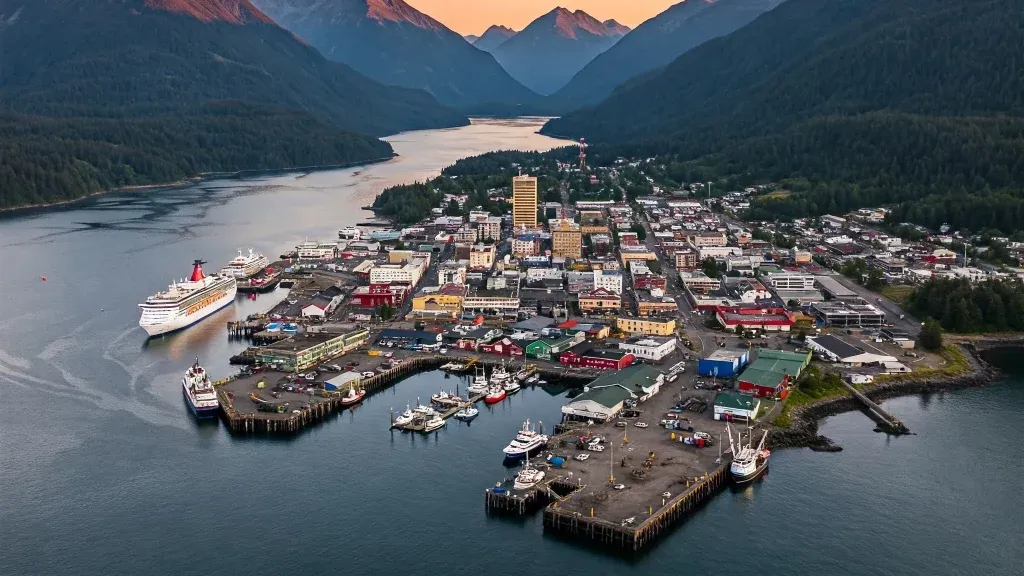 Aerial view of Juneau, Alaska with mountains and water
Aerial view of Juneau, Alaska with mountains and water
- Median House Price: $490K
- Cost of Living: 22.9% Higher than the national average.
- Crime Score: Safer than 7% of U.S. cities.
- Unemployment: 4.5%
- Walkability Score: 84; Very walkable.
Juneau, the capital city of Alaska, is uniquely located in the southeastern part of the state, accessible primarily by air or sea due to the surrounding rugged terrain. It offers residents a distinct blend of government center activity and immediate proximity to dramatic natural landscapes.
Discover the Best – Where to Go on Vacation in Florida
Your Ultimate Guide – what to eat in destin florida
Discover Fun Things to Do in LA Today
The city is famous for being home to the magnificent Mendenhall Glacier and being part of the expansive Tongass National Forest. Its economy is bolstered by government employment, tourism (including popular whale-watching tours), and fishing. Juneau’s blend of career opportunities and unparalleled access to natural wonders makes it a vibrant place to live for those who appreciate both urban and outdoor pursuits.
Choosing the Best Place To Live In Alaska Based on Your Needs
Finding the ideal place to settle in Alaska often depends on individual or family priorities. Different cities cater better to specific demographics based on factors like educational access, job markets, and lifestyle pace. Let’s break down some recommendations.
| Demographic | #1 | #2 | #3 |
|---|---|---|---|
| Single Families | Fairbanks | Kodiak | Wasilla |
| Young Professionals | Badger | Anchorage | Sitka |
| Retirees | Homer | Palmer | Ketchikan |
For single families, locations like Fairbanks, Kodiak, and Wasilla offer community, potential job stability, and varying degrees of access to nature and schools. Young professionals might find Badger, Anchorage, or Sitka appealing due to educational institutions, urban amenities (in Anchorage), or unique environments and job sectors. Retirees often gravitate towards the quieter beauty and community feel of places like Homer, Palmer, or Ketchikan, which offer a more relaxed pace amidst stunning scenery.
Is Alaska a Good Place to Live?
Many factors make Alaska an attractive place to live for a variety of people. The state offers certain tax benefits, including no state income tax and the annual Permanent Fund Dividend. For those who thrive in colder climates and appreciate distinct seasonal changes, the weather can be a cozy draw, though it requires adaptation.
Alaska boasts a robust job market in key sectors like oil and gas, tourism, healthcare, and government. This provides ample opportunities, particularly for young adults and skilled professionals. The state also offers commendable healthcare services and educational institutions across its varied communities, from major universities to local schools.
Living in Alaska: FAQs
Thinking about moving to the Last Frontier? Here are some common questions prospective residents often ask about living in Alaska.
What is the overall cost of living in Alaska?
The cost of living in Alaska is generally higher than the national average, primarily due to transportation costs for goods and services. However, this varies significantly by location, with some cities being more expensive than others.
Are there good job opportunities in Alaska?
Yes, Alaska has a strong job market, especially in resource industries (oil, mining, fishing), tourism, transportation, healthcare, and government sectors. The unemployment rate is relatively low compared to the national average in many areas.
How safe is Alaska?
Like any state, safety varies by location. While some areas have higher crime rates, many smaller towns and specific neighborhoods in larger cities are considered very safe. Researching the crime statistics for specific communities is advisable.
What is the weather like?
Alaska is known for its cold winters and long, dark nights, particularly in the interior and northern regions. Summers can range from mild and rainy in the southeast to warm with very long daylight hours in the interior. Coastal areas are generally milder but wetter than the interior. Adapting to the unique light cycles is a key aspect of living here.
What are the main benefits of living in Alaska?
Key benefits include no state income tax, the annual Permanent Fund Dividend, unparalleled access to outdoor recreation and stunning wilderness, unique cultural experiences, and strong community ties in many areas.
Conclusion
From the bustling urban center of Anchorage to the serene coastal beauty of Sitka and the rugged interior charm of Fairbanks, Alaska offers a diverse range of living experiences. The “Last Frontier” provides unique opportunities, strong communities, and breathtaking natural environments that appeal to adventurers, families, professionals, and retirees alike. While the cost of living can be higher, the lack of state income tax, job prospects, and unparalleled access to nature present compelling advantages. The best place to live in Alaska truly depends on your priorities, but each location on this list offers a distinct way to embrace the spirit of this incredible state.
